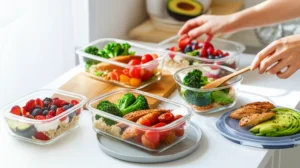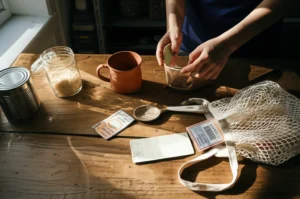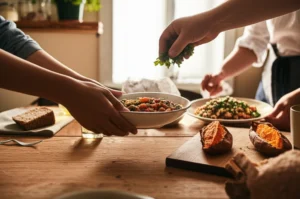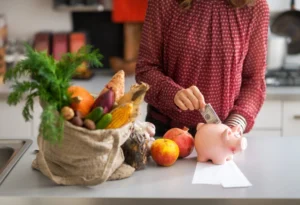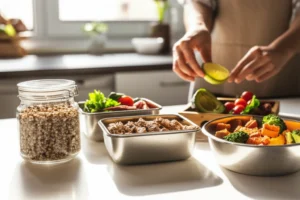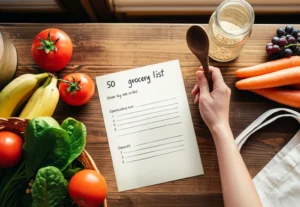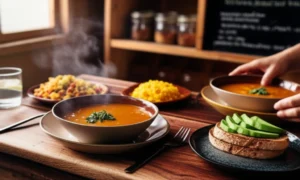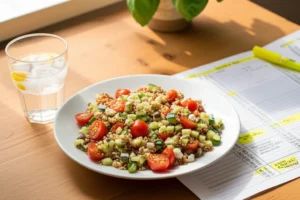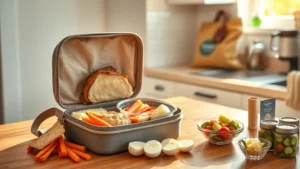Let’s just admit it: grocery shopping when you live alone can feel like a superpower-level challenge. You want to eat well, maybe even enjoy a little variety, but somehow the prices and portion sizes seem designed for entire families, not just you. And then there’s the guilt—wasting food, money flying out the window, scrapping half a tub of sour cream because it went bad. Ugh. Been there, more times than I care to count.
But here’s the thing—you can learn how to grocery shop on a budget for 1 without ending up with a fridge full of leftovers or an empty wallet. It’s all about working smarter, not harder, with a few simple strategies and a little mindset shift. And hey, I’m here to chat you through it, like a friend who’s done the trial-and-error dance. Ready to save some cash and keep your meals tasty? Let’s dig in.
Why Solo Shopping?
Ever Wonder Why It’s So Tricky?
Have you noticed how most grocery stores seem to act like you’re shopping for at least two? Giant packs of chicken breasts, family-sized veggie bags, even the smallest loaf of bread feels too big sometimes. It feels like the universe conspires to make solo shopping expensive and wasteful. And yeah, it’s annoying.
Wisely choosing what to shop for can feel like trying to solve a puzzle without instructions. But here’s a little reality check: when you buy big, you either end up throwing food out or eating the same thing daily until you hate it.
Bulk vs. Solo: A Quick Comparison
| Item | Family Pack Cost | Solo Option Cost | Money-Saving Tip |
|---|---|---|---|
| Chicken Breasts (3-pack) | $9.00 | Single breast $3.50 | Buy single portions when possible or freeze extras. |
| Bagged Salad (large) | $5.00 | Small bunch lettuce $2.00 | Opt for loose greens or frozen veggies. |
Getting familiar with these smaller purchases is a game-changer. Also, if you want tips on what to grab, check out this handy Basic grocery list for 1 that many solo shoppers swear by.
Plan Like a Pro
What’s Your Real Eating Style?
Here’s a question: Have you ever made a killer grocery list… only to end up eating takeout by midweek? Yep, me too. It’s easy to dream of green smoothies and homemade dinners, but reality sometimes looks like cereal for dinner or last-minute pizza delivery.
So before you shop, get honest about your routine. Ask yourself:
- How often do I cook vs. order food?
- Am I okay with leftovers, or do I prefer “one-and-done” meals?
- Do I freeze extra meals or toss them after a day or two?
- How much time do I realistically want to spend cooking?
Answering these saves you from buying stuff you won’t use and cuts your waste—and that’s a huge budget win.
Try This Self-Quiz
- If you rarely cook leftovers, buy smaller portions or ingredients that keep well (think canned or frozen).
- If you love batch cooking, plan recipes that freeze well, making your next meals even easier.
- If your schedule is unpredictable, make a flexible menu with a few staple ingredients you can use in different ways.
Meal Blueprint That Works
Here’s a trick that changed everything for me: The 3-list system. It’s simple but magic.
- Master Shopping List: Everything you normally buy, organized by type (dairy, veggies, pantry staples).
- Master Meal List: Your go-to recipes, with notes on servings and ingredients needed.
- Master Meal Plan: A calendar mixing those meals into your week or month.
You can repeat your favorite meals, which lowers waste and helps your shopping stay on track. This approach is even great if you want to try Basic grocery shopping list ideas and customize them for your tastes.
Money Smarts
Master the Shopping Game
Want to spend less but eat well? Timing is everything. Did you know stores often run predictable sales cycles? Your favorite pasta or frozen veggie brand goes on sale about every 6 weeks, usually. Once you spot the pattern, you can plan when to buy in bulk and when to hold back.
Sales Cycle Table
| Store | Best Sale Day | Good Deals |
|---|---|---|
| Aldi | Wednesday | Frozen veggies, dairy |
| Walmart | Tuesday | Staples, canned goods |
| Kroger | Sunday | Meat, produce |
Also, don’t hesitate to buy generic or store brands—they’re often just as tasty but cost way less. My personal fave: swapping fancy cereal for a no-name brand saved me around $4 each box! Some foods I’m picky about (Oreos, I’m looking at you), but most staples are fine with me. For more on cutting grocery costs, this roundup of the Essential grocery list on a budget is gold.
Stretching Every Dollar
Cutting back on meat is a classic money-saver that works, especially if you’re smart about it. Meat can be pricey, so here’s a little secret—use it like seasoning rather than the whole meal.
Think casseroles with a few chunks of chicken, chili with beans, or a stir-fry where the meat is just flavor. That way, you get protein without blowing the budget. I found beans, lentils, and tofu easy on my wallet and surprisingly satisfying. Plus, frozen veggies are your best friend—they’re cheaper, ready to use, and last forever in the freezer. A simple bag of frozen broccoli can rescue dinner on your busiest days.
The 6-to-1 Grocery Method
Veggies, Fruits, Protein… Oh My!
You might have heard of the viral 6-to-1 grocery method? It’s a fancy way of saying, “Buy six veggies, five fruits, four proteins, three starches, two sauces or spreads, and one fun thing.” Sounds fun, right?
For one, you’ll want to scale it down, but the idea stays powerful: cover a little bit from each category so your meals stay interesting without buying stuff you won’t use.
If you like lists, grab this $50 grocery list for 1 person — it’s packed with real buys that stretch your dollars while staying tasty. I’ve followed it to the letter and saved enough to treat myself to a little fancy cheese on the side. Life’s about balance, right?
Pantry Staples to Rely On
Besides fresh food, you’ll want some essentials in your pantry and fridge that keep well. Small jars of condiments, dried herbs, olive oil, and some canned goods are solid picks. Having these flavor boosters on hand means your meals can go from zero to yum without trips for extra ingredients every time.
From my experience and shopping tips from Food52’s flavor players, stocking these basics kept me cooking without extra trips or wasted food. Curious about building your ultimate solo pantry? This Basic grocery list for 1 fits that bill nicely.
Waste Not, Want Not
Leftovers Don’t Have to Feel Like Punishment
Okay, reality check: no one loves staring at leftovers they forgot to eat. But if you plan well, leftovers can be your secret weapon. Repurpose veggies into soups, freeze single portions of meals for later, or turn stale bread into croutons.
Freeze or Flip?
- If you have half a bunch of herbs, dry or freeze them instead of tossing.
- Cook once, eat twice: make double portions and freeze extras.
- Challenge yourself to a clean-out-your-pantry night once a month. It’s surprising how creative dinner can get.
Yep, that’s a life hack straight from savvy budget pros who found shopping on a budget for one doesn’t have to mean boring meals or waste. And if you want some inspiration to keep things fresh, check out this Basic grocery shopping list curated for just that.
Wrapping It Up
Look, we’ve covered quite a bit here, but the main thing is this: shopping solo doesn’t mean spending more or wasting food. Getting to know what you actually eat, making a plan that fits your life, and sticking to smart shopping strategies make all the difference. Whether you try the 3-list system, lean into the 6-to-1 method, or follow that $50 grocery list for 1 person, you’ll be surprised how delicious and affordable solo cooking can be.
So… grab a notebook (or your phone), make that first plan, and hit the store like the savvy shopper you’re becoming. And hey, remember—it’s a journey. Celebrate small wins and tweaks as you find your rhythm. Feel free to share your stories, wins, or fails. I’ll be rooting for you every step of the way.


